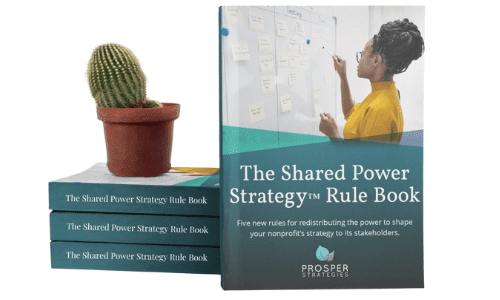I hope you got a chance to download The Shared Power Strategy™ Rule Book last week and have started to think about how you might use it to transform the way your nonprofit thinks about and approaches strategy.
Of all the rules within the Rule Book, Rule #2 is the one that seems the most obvious, yet gets overlooked most often. This rule is all about remembering who we really work for as nonprofit leaders—the people and communities who use and stand to benefit from our programs and services—and then centering their priorities in our strategies. It seems like a no-brainer, but the pressure to put other stakeholders (like funders and donors) first is real, making this rule much easier to believe in than it is to actually abide by.
As challenging as this rule can be to follow, it’s absolutely essential to get it right if your nonprofit cares about making an authentic impact, and spending its time on the right things, for the right reasons.
Read on for an overview of Rule #2, and stay tuned in the coming weeks for a variety of resources and tools that will help you put these concepts into practice.
Rule 2: We Are BENEFICIARY-CENTERED
We put the priorities of those we serve first.
Last week, Rule #1 proclaimed “we are accountable.” But with accountability comes the question: “accountable to whom?”
Our organization commits to holding itself accountable first and foremost to our so-called “beneficiaries”: the people and communities who are reached by our programs and services, and those most affected by the issues we exist to address.
When it comes to shaping our strategies, we center their priorities above all others.
This might sound like an obvious choice, but for many organizations, it’s not. Historically, so many nonprofits have fallen into the trap of centering those who hold the purse strings—namely boards, donors and funders—when developing strategies and accounting for impact. Those benefactors are indeed important for our survival, but we must ask: survival to what end? Maintaining financial sustainability through the good favor of donors and funders is pointless if our work does not adequately address the needs of the people and communities we exist to serve.
[bctt tweet=”Historically, so many nonprofits have fallen into the trap of centering those who hold the purse strings—namely boards, donors and funders—when developing strategies and accounting for impact.” username=”ProsperStrat”]Every time we begin to shape a new strategy or evaluate an existing one, we ensure our beneficiaries are not just in the room, but at the head of the table. We elevate their voices, ensuring they are heard above all others, rather than drowned out by those of donors, board members, or other stakeholders who have historically been considered “more powerful.” We do so with sensitivity to their interest in and accessibility for involvement, using a spectrum of mechanisms for capturing their insights and input, from surveys and focus groups, to interviews to stakeholder committees where participants are compensated for their time.
In cases where our immediate beneficiaries are difficult to engage for input directly (such as with youth, people living with certain disabilities, or those who have recently experienced trauma), we engage people who are in tune with their needs and perspectives, such as families, caregivers and counselors.
We continually ask ourselves how our strategies can better respond to our beneficiaries’ needs and priorities, and when it comes time to measure our impact, we place more weight on their response to our work than anything else.
Download The Shared Power Strategy™ Rule Book
Within it are the five new rules that will transform the way your nonprofit approaches strategy, making the process more effective, inclusive and equitable.

